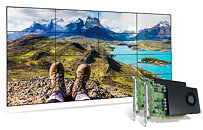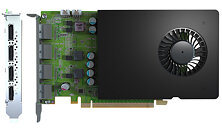Saturday, May 23rd 2020

Matrox Now Shipping D-Series D1480 Graphics Card
Matrox is pleased to announce that the Matrox D-Series D1480 multi-display graphics card is now shipping. Purpose-built to power next-generation video walls, this new single-slot graphics card supports up to four 4Kp60 DisplayPort monitors and can be combined to drive a high-density-output video wall of up 16 synchronized 4K displays. Along with a rich assortment of video wall software and developer tools, the D1480 card enables OEMs, system integrators, and AV installers to deploy high-performance display walls for a broad range of commercial and critical 24/7 applications, including control rooms, enterprises, industries, government, military, digital signage, broadcast, and more.
Backed by innovative technology and deep industry expertise, D1480 delivers exceptional video and graphics performance on up to four 4K DisplayPort monitors from a single-slot card. OEMs, system integrators, and AV professionals can easily add—and synchronize—displays by framelocking up to four D-Series cards via board-to-board framelock cables. In addition, D1480 offers HDCP support to display copy-protected content, as well as Microsoft DirectX 12, OpenGL 4.5, and OpenCL 1.2 support to run the latest professional applications.Proven video wall ecosystem
D-Series cards work seamlessly with Matrox's complete video wall portfolio. OEMs and system integrators can pair D1480 with Matrox Mura IPX capture cards to add advanced HDCP functionality to capture and display content-protected sources—including set-top boxes, Blu-ray Disc and media players, and video game consoles. D-Series can also be combined with Matrox QuadHead2Go multi-monitor controllers to create ultra-large-scale configurations of up to 64 x 1920x1080p60 screens.
Custom Control
D-Series includes the robust and field-proven Matrox PowerDesk desktop management software. Users can select from a variety of advanced tools—including stretched or independent desktops, clone mode, pivot, bezel management, edge overlap, and more—to easily configure and customize multi-display setups. The feature-rich Matrox MuraControl video wall management software meanwhile provides users with an intuitive platform to manage video wall sources and layouts either locally or remotely, and in real time. Matrox video wall APIs, SDKs, and libraries are also available for developers and AV installers interested in creating custom control functions and applications.
"The new Matrox D-Series card enables customers to go beyond 'standard' and explore new levels of video wall creativity," said Fadhl Al-Bayaty, business development manager, Matrox. "Video wall designers can now capture and display HDCP sources, run computationally-intensive applications locally, deploy ultra-high-density-output platforms, and much more—all while benefiting from a high-performance, high-reliability video wall architecture."
For more information, visit the product page.
Backed by innovative technology and deep industry expertise, D1480 delivers exceptional video and graphics performance on up to four 4K DisplayPort monitors from a single-slot card. OEMs, system integrators, and AV professionals can easily add—and synchronize—displays by framelocking up to four D-Series cards via board-to-board framelock cables. In addition, D1480 offers HDCP support to display copy-protected content, as well as Microsoft DirectX 12, OpenGL 4.5, and OpenCL 1.2 support to run the latest professional applications.Proven video wall ecosystem
D-Series cards work seamlessly with Matrox's complete video wall portfolio. OEMs and system integrators can pair D1480 with Matrox Mura IPX capture cards to add advanced HDCP functionality to capture and display content-protected sources—including set-top boxes, Blu-ray Disc and media players, and video game consoles. D-Series can also be combined with Matrox QuadHead2Go multi-monitor controllers to create ultra-large-scale configurations of up to 64 x 1920x1080p60 screens.
Custom Control
D-Series includes the robust and field-proven Matrox PowerDesk desktop management software. Users can select from a variety of advanced tools—including stretched or independent desktops, clone mode, pivot, bezel management, edge overlap, and more—to easily configure and customize multi-display setups. The feature-rich Matrox MuraControl video wall management software meanwhile provides users with an intuitive platform to manage video wall sources and layouts either locally or remotely, and in real time. Matrox video wall APIs, SDKs, and libraries are also available for developers and AV installers interested in creating custom control functions and applications.
"The new Matrox D-Series card enables customers to go beyond 'standard' and explore new levels of video wall creativity," said Fadhl Al-Bayaty, business development manager, Matrox. "Video wall designers can now capture and display HDCP sources, run computationally-intensive applications locally, deploy ultra-high-density-output platforms, and much more—all while benefiting from a high-performance, high-reliability video wall architecture."
For more information, visit the product page.


28 Comments on Matrox Now Shipping D-Series D1480 Graphics Card
The last Matrox card I ever had was a Millennium II, and it was amazing... until 3DFX and nVidia came along and simply destroyed Matrox with their first releases. Matrox could only work in a vacuum, and when other, more competent companies started innovating, Matrox simply did not know what to do, as they simply did not know how to make any kind of technology which could compete... I see it's still the same for them today.
I must admit that it would be interesting to see a review of one of these "state of the art" cards from Matrox.
For what it's worth the G400 MAX put up decent competition when it launched. Could top the charts in some D3D titles.
I do wonder if these cards could cope with MadVR on more than 1 screen at a time, say playing multiple 4K HDR movies at the same time...
One of the last gaming reviews for Matrox. They planned to release the Parhelia II but due to lack of succes on Parhelia 1 it got cancelled.
The Parhelia 1 lacked decent clocks and IPC pretty much. The Radeon 9700 obliterated the Parhelia completely.
www.techpowerup.com/gpu-specs/quadro-p2000.c2931
it seems like an nvidia design
edit: it is nvidia designD1480 and the boost clock of P1000 is 1480.. hmmm both have 47 watts
www.techpowerup.com/gpu-specs/matrox-d1450-quad-hdmi.b7727
www.techpowerup.com/gpu-specs/matrox-d1480-quad-displayport.b7726
It was a long time ago and much messier than that. I think the vendor was running some sort of scam because they listed them as Max online and sent a non-Max. When I asked for the right card they claimed it was out of stock and wanted a lot more money to give me the right product despite listing both models in stock on their website.
>OHOHOHO SURE THIS THING RUNS GAMES LIKE SHIT
It's the gift that keeps giving